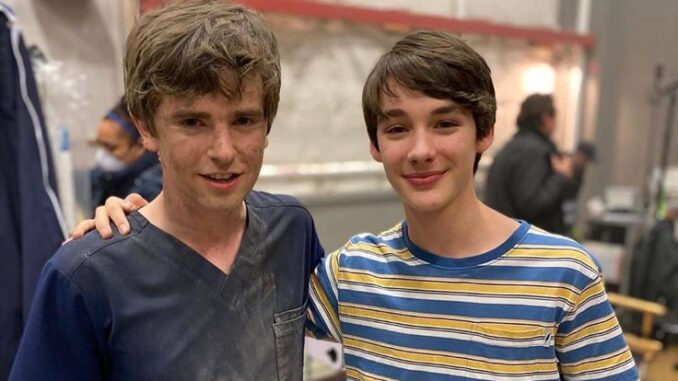
When Freddie Highmore first captured hearts worldwide as the imaginative Peter in “Finding Neverland” (2004), sharing the screen with Johnny Depp, something special was immediately apparent. His performance wasn’t merely cute or precocious—it carried an emotional depth rarely seen in actors of such tender age. The tears he shed and the wonder he portrayed felt achingly real, earning him critical acclaim and establishing him as far more than just another child actor.
This emotional intelligence bloomed further when he donned the iconic purple coat of Charlie Bucket in Tim Burton’s “Charlie and the Chocolate Factory” (2005). Once again alongside Johnny Depp, Highmore embodied the pure-hearted, family-devoted Charlie with such authenticity that audiences couldn’t help but root for him. His performance balanced childlike wonder with an old-soul wisdom, creating a character that felt simultaneously magical and grounded.
“There was something in his eyes,” director Tim Burton once remarked. “A depth, an understanding beyond his years. He could convey complex emotions without saying a word.”
The Transformation Years
As Highmore approached adolescence—the precarious period that has derailed countless child acting careers—he made thoughtful choices that showcased both his commitment to craft and his desire for artistic growth. Rather than pursuing teen heartthrob roles or fading from the spotlight, he balanced education at Cambridge University with carefully selected projects that challenged him.
His turn as Norman Bates in “Bates Motel” (2013-2017) represented perhaps the most daring transformation in his career. Taking on a character made iconic by Anthony Perkins decades earlier, Highmore didn’t imitate—he reimagined. His Norman was a complex study in psychological fragility, a young man fighting against encroaching madness with moments of devastating clarity. The performance required him to oscillate between vulnerability and menace, often within the same scene, showcasing a range that left critics astounded.

“What’s remarkable about Freddie’s performance as Norman isn’t just the darkness he can access,” noted his co-star Vera Farmiga, “but how he makes you empathize with someone sliding into monstrosity.”
The Doctor’s Precision
Just as audiences had adjusted to seeing the former child star as the psychologically damaged Norman Bates, Highmore executed another remarkable pivot. In “The Good Doctor,” which premiered in 2017, he stepped into the role of Dr. Shaun Murphy, a surgical resident with autism and savant syndrome.
The role presented unique challenges—portraying neurodivergence with respect and authenticity while avoiding caricature. Highmore approached the character with characteristic thoroughness, consulting with autism experts and bringing a physicality to the role that communicated Shaun’s different way of experiencing the world without exaggeration or exploitation.
What makes his performance as Dr. Murphy particularly compelling is how Highmore conveys Shaun’s brilliant medical insights. When Shaun visualizes anatomical structures or surgical solutions, Highmore’s subtle shifts in expression communicate the character’s unique cognitive processing with a precision that feels almost mathematical in its execution.
“I wanted to ensure Shaun never became defined solely by his diagnosis,” Highmore explained in an interview. “He’s a fully realized person with hopes, fears, and ambitions like anyone else. The autism is part of who he is, but it’s not all he is.”
The Artist Behind the Characters
Perhaps what distinguishes Highmore most from his peers is what happens between roles. Unlike many actors who develop recognizable personas that carry from project to project, Highmore seemingly disappears into his characters so completely that viewers often experience moments of disbelief when realizing the same person played these wildly different roles.
This chameleon-like quality extends beyond his performances to his public persona—or rather, the notable lack thereof. In an era of social media ubiquity and celebrity oversharing, Highmore maintains a refreshing privacy, letting his work speak for itself. He approaches interviews with thoughtfulness and humility, discussing the craft of acting rather than the trappings of fame.
Behind the camera, Highmore has expanded his artistic repertoire, writing and directing episodes of “Bates Motel” and “The Good Doctor,” demonstrating that his understanding of storytelling extends beyond performance. This holistic approach to filmmaking suggests that Highmore’s journey is far from complete.
The Legacy in Progress
At an age when many actors are still finding their footing, Freddie Highmore has already built a body of work spanning diverse genres, tones, and character types. From the magical realism of his childhood roles to the psychological complexity of his adult performances, he has consistently chosen substance over spectacle.
What makes Highmore’s journey from wonder boy to medical genius particularly compelling is that it doesn’t feel calculated or strategic—it feels driven by genuine artistic curiosity. Each role builds upon the last not in terms of fame or fortune, but in terms of challenge and complexity.
As Dr. Shaun Murphy continues to evolve season after season, so too does the actor behind him. The wide-eyed boy who once gazed in wonder at Willy Wonka’s chocolate factory now brings that same sense of discovery to each new character, each new project. The wonder hasn’t disappeared—it has matured into something even more remarkable: an artist constantly in pursuit of truth, complexity, and connection.
In an industry often defined by fleeting success, Freddie Highmore has built something far more valuable: a career characterized by growth, intention, and authenticity. From wonder boy to genius doctor, his journey continues to unfold with the same thoughtful precision that defines his performances—leaving audiences eager to witness whatever transformation comes next.
